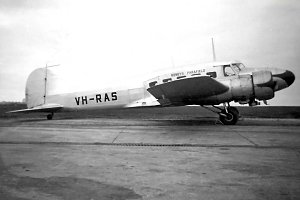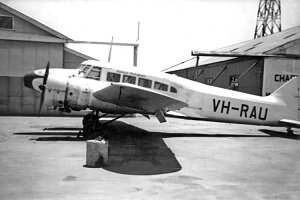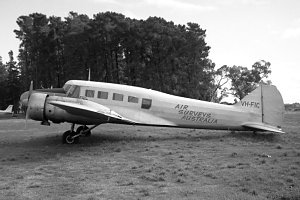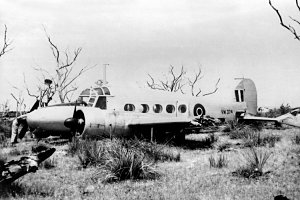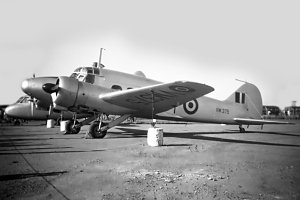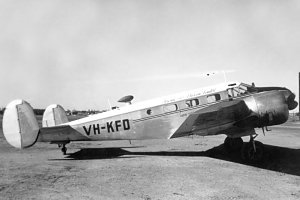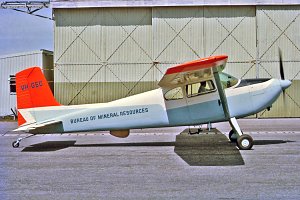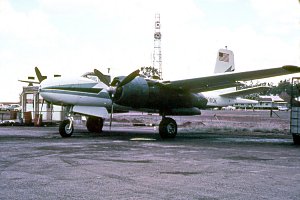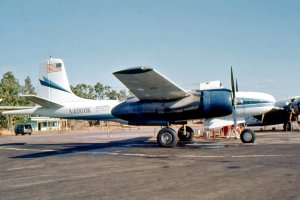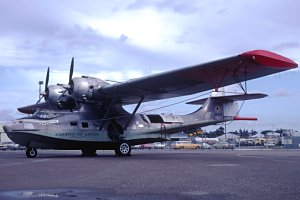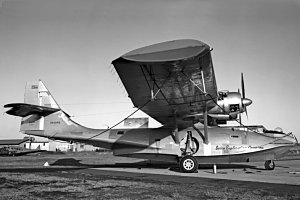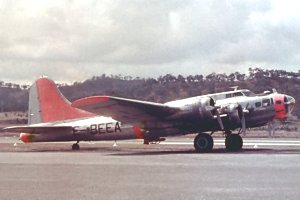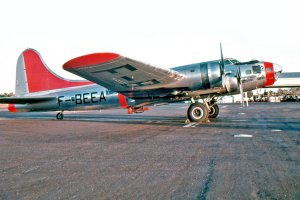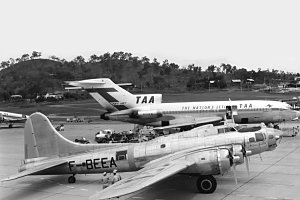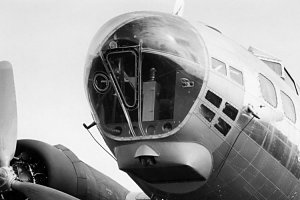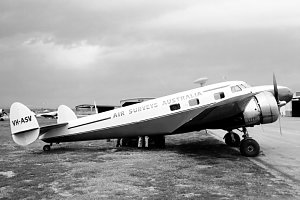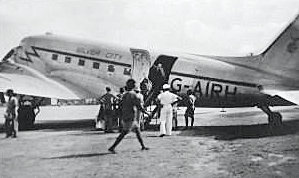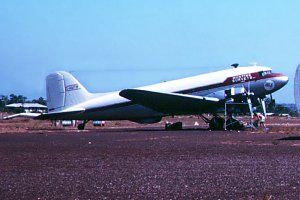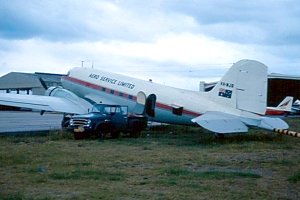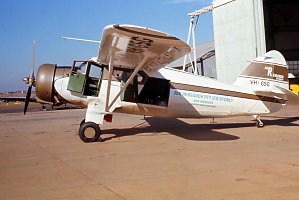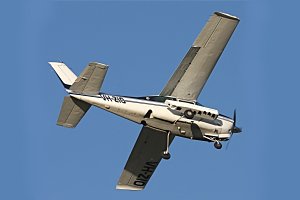|
|
Anson
VH-RAS Robbys
In 1951, Robbys
of Parafield, South Australia won a five-year aerial photography
contract from the South Australian Government and for this purpose
they acquired three Ansons. Two of these aircraft VH-RAS (ex W1532)
and VH-RAU (ex DJ322) were placed in service while the third VH-BJN
(ex EG425) was used as a spares source. VH-RAS soldiered on until
1957 when DC-3 VH-DAS became available to service further S.A.
Lands Department contracts. VH-RAU was withdrawn from service
in 1954. With the official grounding of all wooden winged Ansons
in Australia from 1962, the three Robbys aeroplanes met the same
fate as most Ansons and were broken up.
|
|
|
Anson
VH-RAU Robbys
In 1951, Robbys
of Parafield, South Australia won a five-year aerial photography
contract from the South Australian Government and for this purpose
they acquired three Ansons. Two of these aircraft VH-RAS (ex W1532)
and VH-RAU (ex DJ322) were placed in service while the third VH-BJN
(ex EG425) was used as a spares source. Anson VH-RAU was withdrawn
from service in 1954 and VH-RAS soldiered on until 1957 when DC-3
VH-DAS became available to service further S.A. Lands Department
contracts. With the official grounding of all wooden winged Ansons
in Australia from 1962, the three Robbys aeroplanes met the same
fate as most Ansons and were broken up.
|
|
|
Anson
VH-FIC Air Surveys Australia
Avro Anson
VH-FIC (ex AW658) of Air Surveys Australia was photographed at
Moorabbin in May 1963. By this time the aircraft was withdrawn
from service along with all other Australian wooden winged Ansons
which were officially grounded on 30 June 1962.
|
|
|
Anson
C.19 VM374
This Anson
(along with VM375) had been based at Mallala, South Australia
to support operations at the Woomera Rocket Range. While still
on charge to the RAAF, VM374 was used on survey flights looking
for uranium. The flights were navigated by Flying Officer Mike
Wood who later joined Adastra. The crew included two civilians
from the Mines Department. VM374 was landed wheels up after an
engine failure at low altitude while on a uranium survey flight
near Port Lincoln on 15 December 1953. The aircraft was written
off but there were no injuries to the crew.
|
|
|
Anson
C.19 VM375
This Anson
(along with VM374) had been based at Mallala, South Australia
to support operations at the Woomera Rocket Range. Following the
crash of VM374, uranium survey flights resumed with VM375 which
was flown by Pilot Officer Roy Scaife. The scintillometer was
operated by Maurie Miller, a civilian who later joined Adastra.
|
|
|
Beech
C18S VH-KFD Brown & Dureau
Built for
the USAAF in 1945 as a C-45F (c/n 8468), the aircraft was not
delivered but converted for civil use as a C18S. The aircraft
was registered in the Philippines as PI-C80, Hong Kong as VR-HED
and in the UK as G-ALJJ. The aircraft was sold to Brown &
Dureau of Melbourne and registered VH-KFD on 5 May 1952. The registration
derives from the initials of Brown & Dureau's Managing Director,
Keith F. Dureau. By September 1952, the aircraft had been converted
for aerial photography. Brown & Dureau operated the aircraft
until 21 November 1955 when it was sold to Connellan Airways of
Alice Springs. What remained of the airframe was burned for fire
training at Alice Springs in 1974.
|
|
|
Cessna
180B VH-GEO Bureau of Mineral Resources
Cessna 180
VH-GEO (c/n 50554) of the Bureau of Mineral Resources was photographed
at Moorabbin, Victoria on 28 January 1965. Note the belly mounted
cradle for a towed bird.
|
|
|
Douglas
A-26 Invader N4000K Aero Service Corp
Aero Service
Corp of Manila based Douglas A-26B Invader N4000K (c/n 28041)
at Darwin in 1969 for a mapping contract of Irian Jaya. The Invader
was known to Aero Service personnel as "November 400 Okay". The
aircraft was badly damaged on 4 July 1972 when it landed at Manila,
Philippines with the right main gear retracted. On 25 September
1972, Aero Service Corp in Manila wrote to the FAA asking that
the aircraft be removed from the register as it was "damaged
beyond repair and has been scrapped". This casts doubt on
references which show that N4000K was abandoned at Dili, Portuguese
Timor in 1975. Thanks to Carl Winnefeld for this update (09AUG15).
|
|
|
Catalina
VH-EXG Executive Air Services
Built in Canada
as a Canso A (c/n CV-369) this aircraft was later converted to
a Super Cat with more powerful Wright engines. It arrived
at Essendon, Vic as N609FF on 27 June 1972 and was re-registered
VH-EXG on 30 August 1972. The aircraft was operated on aeromagnetic
surveys by Executive Air Services on behalf of Terra Surveys Ltd
(Geoterrex) of Ottawa. It was photographed at Brisbane, Eagle
Farm on 18 June 1974. Its last flight was on 10 December 1987.
The aircraft has since been restored to military configuration
and is now on display at the RAAF Museum at Point Cook.
|
|
|
Catalina
VH-UMS Selco Exploration
Built in the
USA for the US Navy as a PBY-5A Catalina (c/n 1649) this aircraft
was later converted in Canada to a Super Canso. It was
equipped for aeromagnetic survey work for Selco Exploration Company
of Toronto, Canada. It arrived in Australia as CF-JMS on 11 April
1964. The aircraft was placed on the Australian register as VH-UMS
on 24 April 1964 and commenced operations under the name Australian
Selection Ltd. Surveys were conducted at Mount Isa Qld, Port Pirie
S.A., Leigh Creek S.A., Nyngan NSW as well as in Western Australia.
While based in Australia, it was serviced by Flight Facilities
at Mascot, Sydney. The aircraft was struck off the Australian
register on 7 October 1964 and reverted to CF-JMS. The Catalina
departed from Sydney on 15 November 1964 on return to Canada.
At last report (2000) the aircraft was with the Weeks Air Museum
in Florida, USA as N287.
|
|
|
B-17G
F-BEEA Institut Geographique National
The Institut
Geographique National (IGN) operated a large fleet of B-17s on
survey work from their base at Creil in France. B-17G F-BEEA (c/n
8552) was photographed at Port Moresby, Papua New Guinea on 15
July 1967. The aircraft was sighted earlier in Port Moresby on
22 June 1967. During June 1989 the aircraft was based in the UK
for the filming of the movie Memphis Belle. During the filming,
F-BEEA was destroyed by fire following a take-off crash at RAF
Binbrook on 25 July 1989.
|
|
|
Lockheed
12A VH-ASV Air Surveys Australia
Although clearly
marked "Air Surveys Australia" it is believed that the aircraft
was never actually converted for survey work. The aircraft was
with this operator only briefly, from 1963 to 1965 and it is likely
that it was used mostly for general freight work for associate
company Flinders Island Airlines. The aeroplane is still flying
under its original registration VH-ABH with Ross Smith of Rolleston,
Queensland.
|
|
|
DC-3
G-AIRH
Arrived in
Darwin 23rd Jan 1949 ex South Africa and then the following day
continued directly to Broken Hill after a flight of 10 hrs 05
minutes. Pilots David S. Flett and DW Cox, navigator ER Walsh,
radio operator PD Skingley and 'hostess' Mrs Cox. After unloading
gear G-AIRH flew on to Sydney for extensive maintenance including
a double engine change before returning to Broken Hill 10th Feb
1949. The crew were then joined by the geophysicist Peter Goodeve
(later crew chief on BMR aircraft VH-BUR and VH-MIN). Aeromagnetic
work by G-AIRH was mostly for The Zinc Corporation and its subsidiary
Enterprise Exploration Co Pty Ltd although some work was also
carried out for BHP and WMC. For four or five days in mid February
1949 G-AIRH was flown on a major regional aeromagnetic survey
that extended from Broken Hill as far east as Nyngan NSW and as
far west as Lake Gairdner in South Australia (possibly landing
in Nyngan, Cobar etc in NSW and then Whyalla, Port Pirie, Port
Augusta, etc in SA). Additional survey flying was then made to
Bourke NSW from Broken Hill and return. An extensive aeromagnetic
survey was then carried out based from Broken Hill throughout
the rest of February and through March. Many thousands of kilometers
of survey were flown (15,000 kms or so). From 30th March-4th April
additional reconnaissance was flown by G-AIRH from Cobar extending
as far north as Louth and Bourke and south east to Nyngan. In
mid April G-AIRH flew to Whyalla for BHP and based from there
flew surveys over the known iron ore deposits in the Middleback
ranges (e.g., Iron Prince, Iron Duke, Corunna etc). A reconn traverse
was flown along the Kimba-Whyalla Road. Records from these surveys
has survived. G-AIRH was then flown to WA at the end of April
1949 for a survey for WMC centred on Southern Cross (Bullfinch
to Marvel Loch). It is not known whether the base was Southern
Cross or Kalgoorlie. Following the Southern Cross survey G-AIRH
returned toi the east where in May 1949 it flew a coastal aeromagnetic
survey near and across the SA and Vic border most likely based
from Mount Gambier. After that G-AIRH returned to Cobar for some
follow-up work on specific anomalies located on the earlier surveys.
In late May 1949 G-AIRH ferried to ANA Essendon for a British
CofA and was test flown there 6th June 1949. It flew no more work
in Australia and was back in Joburg by the end of July 1949.
G-AIRH was the first aeromagnetic survey aircraft in Australia
and for this reason a better photograph is much sought after.
(Compiled by Doug Morrison)
|
|
|
DC-3
G-AMYW Hunting Surveys
DC-3 G-AMYW
(c/n 33020) was registered to Hunting Aerosurvey Ltd of the UK
on 12 August 1953. It was photographed at Darwin in 1965 when
it was operating in conjunction with Adastra's Hudson VH-AGE.
G-AMYW was damaged beyond repair in an accident in Saudi Arabia
on 8 April 1967.
|
|
|
DC-3
VH-MJR Aero Service Limited
Formerly NC9032H
with Aero Service Corp of Philadelphia, this DC-3 (an ex USN R4D-4
c/n 6353) operated briefly in Australia as N9032H but was re-registered
VH-MJR on 18 August 1961 for survey operations in Australia under
the name Aero Service Limited. It was photographed at Mascot,
Sydney in 1965 with Adastra's Hangar 13 in the background at left.
VH-MJR was sold to Mac.Robertson Miller Airlines and re-registered
VH-MMT on 8 June 1965. MMA sold the aircraft in Indonesia in 1969
and it is believed to have ended its days there.
|
|
|
Noorduyn
Norseman VH-GSG Air Research Pty Ltd
Built as a
UC-64A (c/n 269) this Norseman entered service with the RAAF as
A71-12 in 1944. Post-war it was sold to Silver City Airways of
Broken Hill as VH-BHG and used in the logistical support of mining
operations. In 1951 ownership changed to Zinc Corp who two years
later sold the aeroplane to Gibbes Sepik Airways of PNG. While
with this operator, the registration was changed to VH-GSB, then
VH-RHG, then finally to VH-GSG. After a crash while being used
as a crop duster, the aircraft was sold to Skyservice Aviation
of Camden and in 1971, leased to Air Research of Sydney for aerial
mineral survey. VH-GSG served with Air Research until late 1971
after which it was exported to Canada in 1973 and destroyed in
a crash in 1978.
|
|
|
Caravelle
N1001U Aero Service
Caravelle
6R N1001U (c/n 86) was the first of a fleet of twenty ordered
by United Airlines. It was accepted by United in May 1961 and
named Ville de Toulouse. United sold the aeroplane in 1971
at which time it was converted for aerial survey work with a multi-spectral
camera and side-looking radar. The aircraft was operated by Aero
Service of Houston, Texas on behalf of Goodyear Aerospace, Litton
Industries and Western Geophysical. During 1971-73 the aircraft
was leased in Brazil as PT-DUW mapping the route of the Trans-Amazon
Highway. The Caravelle also operated from Mount Isa, Qld and in
PNG. This aircraft is preserved at the Pima Air & Space Museum
in Tucson, Arizona.
|
|
|
Cessna
210N VH-ZIO NearMap
21st Century Bookend
This Cessna
210N VH-ZIO (c/n21064644) is one of a pair used by NearMap to
produce their online digital maps. The other aircraft, also a
Cessna 210, is registered VH-ZID. Imagine what the pioneers of
aerial survey would think of this technology, let alone the ability
to access it on a thing called the Internet.
(I know I said no lighties but this one gets a guernsey because
it demonstrates how far aerial survey has come, and no, I will
not be adding an image of a satellite - or a drone!)
|
![]()
